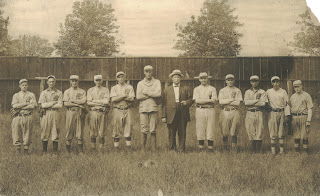TORONTO, OHIO LAYS CLAIM TO THIS DISTINCTION
 |
| GUIESSEPPI MORETTI |
 |
| THE COUNTRY'S FIRST WORLD WAR I MEMORIAL |
Despite
its Canadian name, Toronto, Ohio has always been a city of patriotism and
fierce national pride as currently displayed by its array of American flags
lining its streets. But never was
Toronto’s patriotism more fervid than when it unveiled the nation’s first
monument dedicated to the American soldiers and sailors who had fought in World
War I.
It
was November 11, 1919, Armistice Day, one year after hostilities of the great
war had ended that as many as an estimated 12,000 to 15,000 people amassed in
Toronto streets, which were decorated with patriotic colors from one end of the
river-edged town to the other.
These spectators watched a parade of 3,000 marchers, led by 250
soldiers, sailors and marines, trailed by the Toronto band, various civic
organizations, as well as 800 school children all carrying tiny American flags.
After
the paraded concluded, the soldiers marched to town square where the War
Commission awarded the servicemen bronze medals and made a few speeches, and
then the honored defenders and public dignitaries crossed Market Street to the
First Presbyterian Church where they ate a chicken diner prepared under the direction
of Mrs. Mary Hanna and assisted and sponsored by the Daughters of America.
After
diner, the servicemen stepped outside under mild mid-autumn weather across to
town square as the shadow of the five-ton statue canted eastward under the
two-o’clock sun. A large white
cross now loomed on a platform before the veiled monument and standing before
it were eleven girls clad in white, clasping a red rose, each girl representing
the ten fallen sons and one fallen daughter of the Toronto area.
The
crowd of 3,000, settled and quiet, watched with eager anticipation a Miss
McClean draw the cord encasing the ten-foot high monument that many of them had
personally contributed to financially.
As Miss McClean swept her arm toward the glistening bronze statue, the
crowd erupted into resounding applause.
Present
at the unveiling was Guiesseppe Moretti, whom the Toronto War Board had
commissioned to sculpt the monument, of which the artist stated, “It represents
the glorious liberty with the American soldiers and sailors by her side.”
Moretti,
62 years of age at the ceremonies, was an Italian émigré who had gained fame in
America for his public monuments cast in bronze and marble, most notably his
work “Vulcan” in Birmingham, Alabama, still the largest cast iron statue in the
world. Other important works of
his included the Stephen Collins Foster memorial and the entrance to Highland
Park in Pittsburgh, where he had resided much of his life.
Moretti
was known as an eclectic personality who always wore a green tie. Undoubtedly he was wearing his
trademark color as he stepped off the podium, standing before the towering
five-ton memorial he had completed in just six months.
Next
United States Congressman Benjamin Frank Murphy took the platform. Murphy, a Republican representing the
district, won election for six successive terms. He gave a brief speech of welcome to the crowd and
servicemen and then introduced keynote speaker William D. Upshaw, recently
elected by Georgia voters to Congress.
A
son of a Confederate soldier and a staunch Southern Baptist, Upshaw was a
strong supporter of the temperance movement, so much, in fact, he was known as
the “driest of drys.” Prior to his
election to Congress, Upshaw served as vice president for the Anti-Saloon
League and was instrumental with making prohibition a Georgia law by 1907.
Upshaw,
suffering from a spinal injury that occurred at age 18, and now 52, leaned upon
crutches as he addressed the crowd with his passionate deep Southern
drawl. “I congratulate Toronto,
Ohio on being the first community in America to erect and dedicate a monument
to the glory of the living and the memory of the dead who fought for the safety
of America and for the living of the world.”
After
several minutes of continued praise for the town’s patriotism and for its being
a role model as an American melting pot, Upshaw segued into sermonizing upon
the other war that was threatening the individual’s freedom. “…in order that America may be kept
clean for them—for those who come back to us in buoyant manhood or stagger back
to us maimed or blind, reaching out their hands for encouragement from the
nation for which they offered their all.
We have learned that if it required a sober citizen to live well and
teaching this vital lesson to the nations now new-born in their freedom from
autocracy, but still shackled by the slavery of drink, is America’s new mission
to the peoples who have been set free.”
Ironically,
Upshaw’s visit to the Gem City failed to influence the citizens’ attitude
toward consumption of alcoholic beverages because a little more than 50 years
later in 1970, a poll conducted by “Time Magazine” listed Toronto the city
consuming the most alcohol per capita in the United States.
In
1932, Upshaw ran as presidential candidate for the Prohibition Party against
Franklin D. Roosevelt, who favored the repeal of prohibition, and was
overwhelmingly defeated.
 |
| William D. Upshaw |






